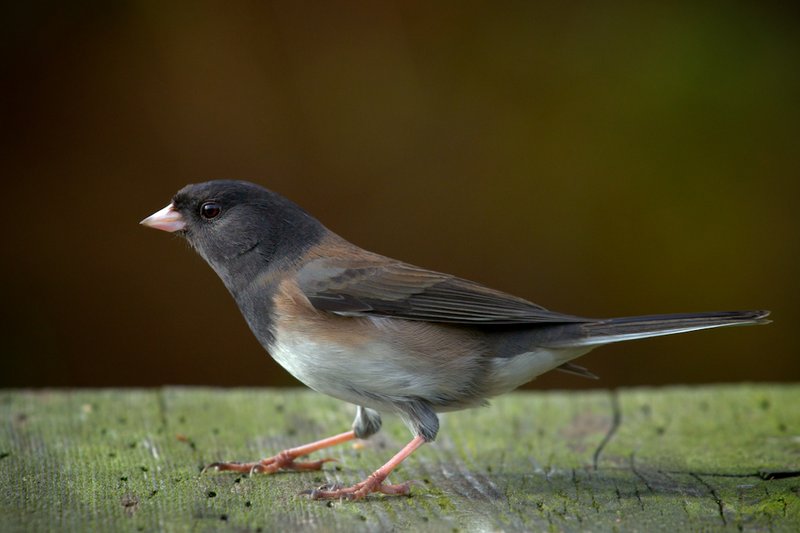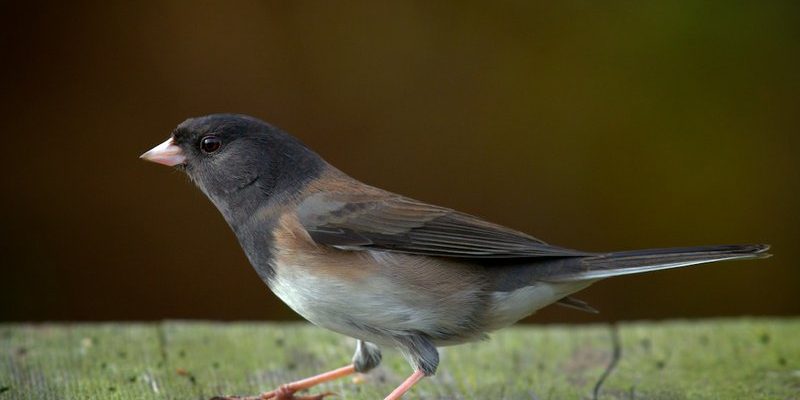
The Dark-Eyed Junco is a charming little bird that you might have spotted flitting about your backyard or a nearby park. With its slate-gray body, white belly, and delicate pink bill, this small songbird is not just pretty to look at but also fascinating in behavior and habits. Think of it as the friendly neighbor of the avian world—always around, often chirping, and a delight to see.
These birds have a special knack for adapting to various environments, which makes them a common sight across North America. They’re like the travelers of the bird kingdom, moving from place to place with the changing seasons. Whether you’re an avid birdwatcher or just someone who enjoys nature, learning about the Dark-Eyed Junco can add a splash of interest to your day!
Physical Characteristics
The physical features of the Dark-Eyed Junco are quite striking and contribute to its charm. Adult males typically have a rich, slate grey body, while the females have a more muted palette, often showing brownish tones. Their underparts are usually white, contrasting beautifully with their darker backs. This coloration provides a sense of elegance, akin to a small, feathered tuxedo. They also have a distinctive white outer tail feather that is visible when they fly or land, adding to their visual appeal.
In terms of size, these birds are relatively small. Adult Dark-Eyed Juncos measure about 6 to 7 inches in length, with a wingspan of around 9 to 10 inches. You might find it interesting to know that they weigh between 0.7 to 1.4 ounces. Despite their small size, they exhibit a robust body structure that allows them to thrive in various habitats. The Dark-Eyed Junco also features a conical bill, ideal for their seed-based diet, which they forage for on the ground.
What’s truly fascinating is how their physical traits have adapted over time. Depending on their geographical location, their coloration might shift slightly. For instance, Juncos found in the western United States often display a darker plumage than their eastern counterparts. This diversity makes them a subject of interest for ornithologists and bird enthusiasts alike.
Habitat and Range
The Dark-Eyed Junco is a bird of many homes. You can find them in a variety of environments, from dense forests and scrublands to your well-kept suburban yards. During the breeding season, they tend to favor coniferous forests, where they can find plenty of cover and nesting spots. Once winter arrives, their adaptability shines as they migrate to lower altitudes and urban areas, making them easier to spot as they search for food.
When it comes to range, Dark-Eyed Juncos are quite widespread across North America. They breed in Canada and the northern United States, but you can often see them in the southern states during the colder months. Imagine them as tiny wanderers, moving from snowy peaks to the sunnier climes of the south. Their migratory habits not only help them survive but also introduce them to new environments and food sources.
What’s important to note is that while they are prevalent throughout the continent, local populations can vary greatly. Some areas may see a large influx during migration, while others may host a stable population year-round. Observing these shifts can be a delightful exercise for birdwatchers, as it allows for a dynamic experience of local wildlife.
Diet and Feeding Habits
When it comes to dining, the Dark-Eyed Junco is a seed lover at heart. Their diet primarily consists of seeds, particularly from grasses and weeds. You might spot them scratching at the ground, using their beaks to uncover hidden treasures beneath fallen leaves or snow. They’re like little culinary explorers, constantly searching for the next snack. In addition to seeds, they also indulge in small insects and fruit during the warmer months, making their diet diverse and adaptable.
One of the intriguing aspects of their feeding behavior is how they forage in mixed flocks. During winter, you will often see groups of Juncos scrounging together, a practice that not only makes finding food easier but also helps them stay safe from predators. They are social eaters, and their numbers can create a lively atmosphere in your garden, especially when you provide bird feeders stocked with seeds.
People who love to attract birds can create a welcoming environment for Dark-Eyed Juncos by planting native bushes and trees that provide seeds and berries. By doing so, you’ll not only enjoy watching these delightful creatures but also contribute to a vibrant ecosystem in your own backyard.
Behavior and Social Structure
Dark-Eyed Juncos are known for their lively behaviors and friendly demeanor. They often exhibit social interactions that can be quite entertaining to observe. When they’re not busy foraging, you might catch them engaging in playful flights or vocalizing with each other. Their songs are typically soft and sweet, featuring a series of gentle trills that sound almost like whispers of friendship among the branches.
During the breeding season, males become especially vocal, using song to establish territory and attract females. Their courtship displays include fluttering and hopping, showcasing their agility and vibrant personalities. It’s like watching a tiny bird ballet! They build their nests close to the ground in shrubs or grass, often hidden away for safety.
Once the young hatch, both parents are involved in caring for them. This cooperative breeding behavior not only helps ensure the survival of their chicks but also strengthens the bond between the adult birds. You might find this aspect of their lives particularly heartwarming—seeing both mom and dad working together to nurture their family.
Conservation Status
As of now, the Dark-Eyed Junco is not considered threatened or endangered, which is good news for bird enthusiasts. Their adaptability and wide distribution have allowed them to thrive in various environments. However, like many wildlife species, they face challenges due to habitat loss and climate change. Urbanization can disrupt their natural habitats, making it essential for us to be aware of our impact on these beautiful creatures.
Conservation efforts, such as creating bird-friendly spaces and preserving natural habitats, play a crucial role in safeguarding the future of Dark-Eyed Juncos and many other bird species. It’s about creating a balance where humans and nature can coexist harmoniously. By planting native species in your garden and supporting local conservation initiatives, you can make a difference.
Moreover, engaging in birdwatching and promoting awareness about our feathered friends fosters a greater appreciation for wildlife. The Dark-Eyed Junco serves as a reminder of nature’s resilience and beauty. Every little action counts when it comes to preserving our planet and the biodiversity it holds.
Interesting Facts
| Scientific Name: | Junco hyemalis |
| Size: | 6 to 7 inches in length |
| Weight: | 0.7 to 1.4 ounces |
| Wingspan: | 9 to 10 inches |
| Habitat: | Forests, shrublands, urban areas |
| Diet: | Seeds, insects, berries |
| Lifespan: | Up to 13 years in the wild |
The Dark-Eyed Junco is more than just a pretty bird flitting about your backyard. Its adaptability, charming personality, and delightful behaviors make it a special part of our natural world. Whether you’re an experienced birdwatcher or someone just starting to notice the wildlife around you, taking the time to learn about these little birds can deepen the joy of connecting with nature.
So the next time you see a Dark-Eyed Junco, take a moment to appreciate its beauty and the role it plays in our ecosystems. With each sighting, you’re witnessing a part of nature’s intricate tapestry, reminding us all to pause and enjoy the small wonders that surround us.
FAQ
What is the best way to attract Dark-Eyed Juncos to my garden?
To attract Dark-Eyed Juncos, consider setting up bird feeders stocked with black oil sunflower seeds, which they love. Additionally, planting native shrubs and grasses can provide natural food sources and nesting materials. Offering a small water source, like a birdbath, can also create a welcoming environment for these little visitors.
Do Dark-Eyed Juncos migrate?
Yes, Dark-Eyed Juncos are migratory birds. They typically breed in Canada and the northern United States during spring and summer. As winter approaches, they migrate south to lower altitudes and urban areas where food is more accessible. This migration is a fascinating aspect of their behavior, allowing them to adapt to seasonal changes.
Are Dark-Eyed Juncos solitary or social?
Dark-Eyed Juncos are generally social birds, particularly during the winter months when they often gather in flocks. This social behavior enhances their foraging success and provides safety in numbers. You can observe them chatting and chirping in groups, adding a lively atmosphere to your outdoor space.
What do Dark-Eyed Juncos eat?
The diet of a Dark-Eyed Junco primarily consists of seeds from grasses and weeds. They also eat small insects and fruits during the warmer months. Their foraging behavior involves scratching at the ground to uncover food, showcasing their resourcefulness when it comes to finding sustenance.
How can I identify a Dark-Eyed Junco from other similar birds?
Identifying a Dark-Eyed Junco can be easy with a few key features. Look for their slate-gray body, white belly, and distinctive pink bill. Their white tail feathers are also a good identifying mark seen when they take flight. Additionally, pay attention to their size; Juncos are typically smaller than many other common backyard birds.
What are some of the threats facing Dark-Eyed Juncos?
While Dark-Eyed Juncos are not currently endangered, they do face threats like habitat loss due to urbanization and climate change. These factors can disrupt their natural habitats and food sources. It’s crucial to create awareness about the importance of preserving their environments to ensure their continued presence.
Can Dark-Eyed Juncos be kept as pets?
Dark-Eyed Juncos are wild birds and are best appreciated in their natural habitat rather than kept as pets. They thrive in their native environments and have specific needs that can be challenging to replicate in captivity. Observing them in the wild can provide a fulfilling experience without compromising their well-being.
How long do Dark-Eyed Juncos live in the wild?
In the wild, Dark-Eyed Juncos can live up to 13 years under favorable conditions. However, many factors, like predation and environmental stresses, can impact their lifespan. Observing their behaviors and interactions contributes to our understanding of their life cycles.
What time of year is best for observing Dark-Eyed Juncos?
The best time to observe Dark-Eyed Juncos is during the fall and winter months when they migrate to lower altitudes and urban areas. They can often be seen foraging in gardens, parks, and wooded areas. During this time, their social flocks make them easier to spot and enjoy.
Do Dark-Eyed Juncos have any predators?
Yes, Dark-Eyed Juncos face various predators, including hawks, cats, and snakes. Their natural camouflage helps them evade some threats, but they remain vigilant. Understanding their behavior in relation to predation offers insights into their survival strategies and the challenges they face in the wild.

